5G Mobile is in Danger of Becoming the Next M2 Bradley Tank
Let’s get something straight, the next generation of 5G mobile technology probably won’t bring about world peace, fix famine, cure cancer or save that baby from a burning building; at least not literally. It’s a telecoms network upgrade, not superman. But in listening to some of the politicians speak you’d be forgiven for thinking that it could perform miracles.
At present not a week seems to go by when somebody somewhere isn’t talking about 5G technology, which has yet to even be defined and probably won’t be decided upon for another 2-3 years while the Research and Development phases of various competing projects continue (there are many and they’re all spread across the globe).
Advertisement
After that phase is done then we probably won’t see a commercial roll-out until at least 2020, which assumes that they can turn it into a practical and cost effective upgrade for existing Mobile Network Operators (this should be a key requirement). So at some point somebody somewhere will need to make a decision about standards and that’s going to be tough with such an increasingly thick and convoluted soup of opinion and expectation already building around the service.
The situation has arguably been made far more convoluted by the seemingly rabid interest of politicians, which somewhere along the lines have turned 5G into a revolutionary technology, with huge capabilities, rather than a more natural evolutionary one. Not that this is a bad thing, but it’s all starting to remind us a bit of the troubled development cycle that sprang from the USA’s M2 Bradley fighting vehicle.
The M2 Bradley is a light “tank” (APC) designed for reconnaissance, manoeuvrability and troop transportation. It’s not a bad tank (modern incarnation), but its development cycle is also the stuff of legend, as comically depicted in the 1998 HBO film The Pentagon Wars. This turned what should have been a short and relatively inexpensive process, by military standards, into a monster.
In the film the tank starts life as a simple armoured personnel carrier to replace the aging M113, but along the way a mix of political interference and military mismanagement creates a nightmare for the engineers who have to meet their ever rising expectations and demands.
Advertisement
Over the course of many years and billions of $ the Bradley morphs from an APC to a tank, to a scout vehicle, to a hybrid of the two and various other things, while always having to make compromises in order to achieve the changing goals. The end result is a vehicle that’s not much good at anything, least of all its originally envisaged APC role. One of the best scenes from the film, which depicts this process of failure, is sampled below for your viewing pleasure.
The risk is that 5G could be in danger of following a similar path. Early on 5G was talked about as needing to deliver peak speeds of 10Gbps (shared capacity), which is about ten times more than what we might expect to see from 4G LTE-Advanced networks in the next few years. Soon after that people started talking about 50Gbps, then 100Gbps and recently one team even claimed they could do 1Tbps (this was actually just a simulation).
Today we also hear from Europe about how 5G will be used as a boost for the Internet of Thing (IoT) via connecting a “massive number of sensors” and how it should be “flexible and rapidly adapt to a broad range of requirements” (here). The EU also expects 5G networks to encompass optical, cellular and satellite solutions etc.
Admittedly most of this sounds plausible and setting high standards is of course a good thing, we need to do that, but this shouldn’t come at the cost of engineering reality and the need for practical or cost effective implementations. 5G cannot perform the impossible or be all things to all people and it will still be limited by the laws of physics.
Advertisement
The lesson of the M2 Bradley is a simple one, set a firm design goal and then stick to it, lest you create a monster development cycle that can also become a black-hole for any money thrown its way. Some might say that past 3G and 4G development cycles have arguably already suffered from some of this, yet it’s starting to feel like 5G might be more at risk than any of its predecessors.
But hopefully that won’t be the case and in a few year’s time we’ll all be reaping the benefits.
Mark is a professional technology writer, IT consultant and computer engineer from Dorset (England), he also founded ISPreview in 1999 and enjoys analysing the latest telecoms and broadband developments. Find me on X (Twitter), Mastodon, Facebook, BlueSky, Threads.net and Linkedin.
« UK ISP Urban Wimax Rebrands to Luminet Following Acquisition
A Quick Happy Easter 2015 from ISPreview.co.uk »


















































Comments are closed